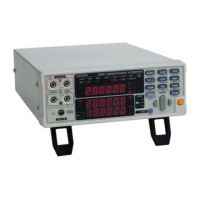27
2.9 Selecting the Measurement Terminals
About Input Terminal Usage______________________________________
The factory-default input terminal selection is INPUT A, the four
(banana jack) terminals, enabling use of Hioki's various test-lead
options.
INPUT A A 10 nF capacitor is connected between the H-L terminals of INPUT A.
This capacitance is intended to improve the stability of high-resistance
measurements and measurements of inductive loads. However, this
also slows the response time for high-resistance measurements.
The approximate response time required to display about 95% of the
resistance of a test object is:
Response time [s] = 3 x Resistance [Ω] x 10 x 10
-9
[F]
Even with the 10 nF capacitor, stability cannot be assured with all
inductive loads. Inductance of 10 H or more may cause instability. In
such cases, connect a 0.1-µF or larger capacitor between H and L, or
contact your supplier or Hioki representative for other solutions.
For fast response with high-resistance measurements, use INPUT B
(the multipolar connector), which has no 10-nF capacitor. However,
because INPUT B has no (10 nF) capacitor, measurements may be
unstable with some inductive test objects.
INPUT B INPUT B offers the advantages of being less affected by
thermoelectromotive force than the four separate terminals of INPUT
A, and is more suitable for high-speed measurements due to the
shielding. When you need to take measurements faster than once per
PLC (power line cycle) without OVC (Offset Voltage Compensation),
use INPUT B.

